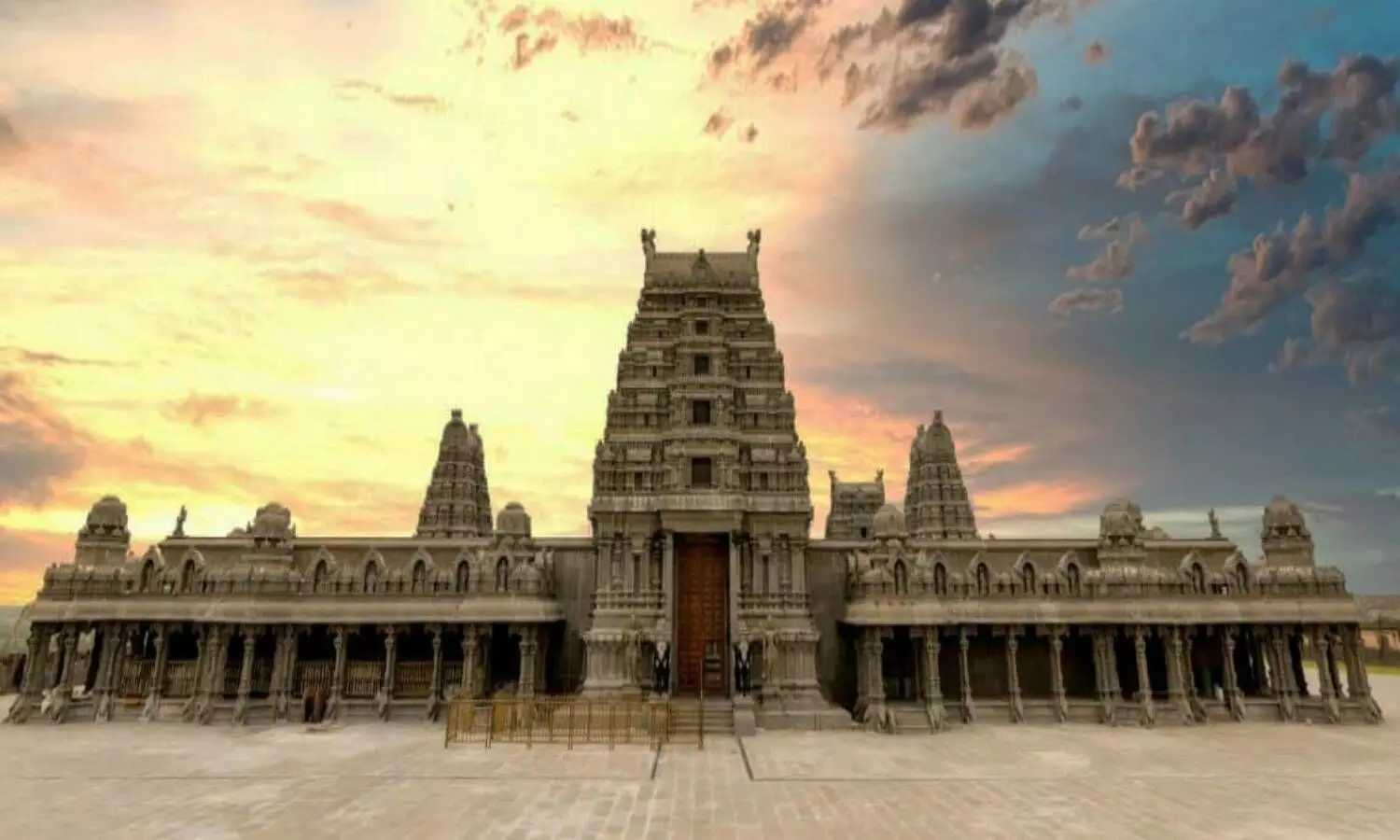After 5 years, renovated Yadigirgutta temple set to reopen on 28 March with new, improved facilities
The renovation of the temple has been done with the primary aim to provide various facilities to pilgrims — from QR-enabled tickets to free shuttle services to inclusive queue lines, and much more. The temple has a brand-new look and a number of new facilities for the pilgrims to look forward to.
By Amrutha Kosuru
Hyderabad: The Yadigirgutta temple is set to reopen on 28 March after five years. The popular hill shrine in Telangana is no longer just a cave shrine. It is now a 17-acre, three-storey temple with seven gopurams. The new temple has been built around the 1,000-year-old shrine without disturbing or altering it.
The renovation of the temple has been done with the primary aim to provide various facilities to pilgrims — from QR-enabled tickets to free shuttle services to inclusive queue lines, and much more. The temple has a brand-new look and a number of new facilities for the pilgrims to look forward to.
How the temple was built?
Only Krishnashila rocks were used in carving the sculptures. Rocks weighing 2.5 lakh tonnes were quarried and transported to Yadigirigutta over the years. Not an ounce of cement has been used to make the temple. Lime was used instead of cement. Traditional construction methods were used to build the temple.
Anand Sai, the chief architect of the temple, visited several temples across south India and drew inspiration from them for Yadagirigutta. "The old temple hasn't been touched. The Swayambhu (the original temple grounds) and Garbhugudi (main temple) are as they are," he said.
The Hanuman carving and other parts of the cave temple have remained untouched. The new temple has been built around it.
Anand explained that he was inspired by Dravidian architecture and said that many might feel like they are inside an old Madhurai temple. "The seven gopurams have been inspired by Srirangam temple in Tiruchirapalli. There are four gopurams on each side and three in the middle of the temple," he said.
The Vimana Gopuram (main Gopuram inside the temple) has been covered in gold weighing about 12 kilos and is 56 feet high. This has been inspired by the Sri Venkateshwara Swamy Temple in Tirupathi, Andhra Pradesh. The total cost of expansion of the temple amounts to Rs 1,200 crores. CM KCR wished to cover the Vimana Gopuram with gold and has sought out donations from various devotees for the same.
The Rajagopuram (pyramidal structure at the entrance of the temple) is seven-storey high and made of stones weighing 13,000 tonnes.
Queue lines and lights
Spacious and in accordance to Vastu and Agama Shastra, another unique feature about the temple are the queue lines. "Yadagirigutta is a very popular temple. Earlier, the temple area was quite small. When the development of the temple began, the primary aim was to provide all the necessary facilities for the pilgrims," Anand explained.
"We didn't just increase the area of the temple but we have designed the queue lines in such a way that they provide a divine experience to the public," he added.
Another striking feature of the temple is its lighting. "Thousands of bulbs have been installed around the temple. After sunset, the whole temple will be lit and it will ensure that the temple is visible from as far as three-four km away," Anand explained.
More ladoos, fewer lines
YTDA vice-chairman G. Kishan Rao told NewsMeter, "Long lines for collecting prasadam and high demand for it has always been an issue of concern. Even though the new temple is not open at the moment, we run out of prasadam by the end of the day and there are long lines. From April, we will have mechanised machinery to make ladoos."
Mr. Kishan Rao explained that the ladoos are hand-molded in Yadadrigutta but now a machine will role all the ladoos with the raw material made by the temple authorities. "Using the machinery, we will be able to produce 50,000 ladoos at a time," he said. He assured that this will not change the quality or quantity of the laddoos.
"As many as 20 ticket counters will be set up on top of the hill. Our aim is to reduce long lines and issue tickets within two minutes. All tickets will be enabled with QR codes similar to Tirumala Tirupathi Devasthanam in Andhra Pradesh," Mr. Kishan Rao said.
The tickets will be issued every hour. The Electronic Corporation of India Ltd. (ECIL) will handle the operating of QR-coded tickets.
"Once devotees enter the queue complex, we will ensure that their darshan is completed within an hour," he said.
YTDA will also provide free shuttle services from the bus station to the hilltop. Additionally, all pilgrims visiting the temple can have food at the Nithya Annadhanam throughout the day.
Safety and comfort
In a bid to ensure that both the Yadigirigutta and surrounding areas of the temple are safe, CCTV cameras have been installed across the temple. "Cameras have been installed on the bridge over Rayagiri Lake as well," he added.
"Earlier, there were no lifts or escalators in the vicinity of the temple. Now, the temple has two lifts and escalators which the public can use. This has been specially built keeping senior citizens and physically challenged persons in mind," Mr. Kishan Rao said.
Accommodation for pilgrims
At present, as many as 300 families can find accommodation in Yadadri, Mr. Kishan Rao said. "The real estate around the temple is also booming. Several presidential suites and guest houses have also been built on the adjacent hills of the temple," he added.